First Look: Samsung Galaxy S8
by Matt Humrick on April 21, 2017 8:55 AM EST- Posted in
- Smartphones
- Samsung
- Galaxy
- Mobile
- Snapdragon 835
- Galaxy S8
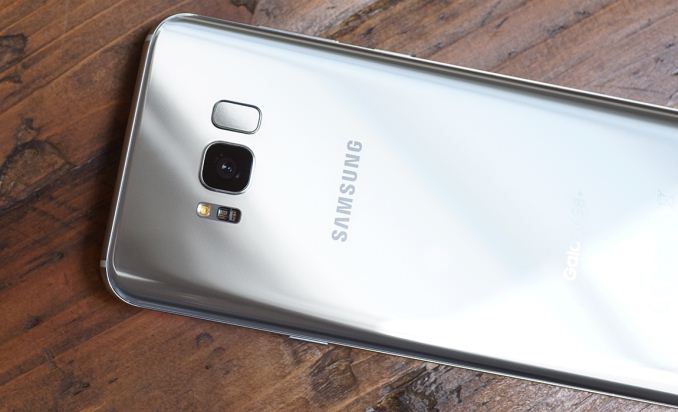
We first saw Samsung’s new 5.8-inch Galaxy S8 and 6.2-inch Galaxy S8+ at its Unpacked event a few weeks ago. During the event, we saw demos of its new virtual assistant, Bixby, and its DeX docking station, which allows the Galaxy S8 to provide a desktop-like experience by connecting to an external monitor and peripherals, but we didn’t have much time with the phones to do much more than take some pictures and try a couple of the new features. After receiving a Galaxy S8 earlier this week, we wanted to give you some feedback about its design and biometric features, as well as, an initial performance and battery life assessment before we dive into our usual in-depth testing.
My biggest complaint about the design is the location of the fingerprint sensor, which I discuss in the video above. It has been relocated to the back next to the camera, making it difficult to reach and use. The new face unlock feature, the second of the S8’s three biometric authentication options, is flawed too. Despite my best efforts, I was not able to get face unlock to work, not even once. The feature, which relies solely on the front-facing camera for identification, also is not very secure, assuming it works at all. It has already been shown that simply holding a picture in front of the camera is enough to fool it into unlocking the phone. The camera really needs to be augmented with an infrared camera to detect a face’s heat signature as a liveness test, or a second, depth-sensing camera to at least detect a face in three dimensions. So far the iris scanner, which I also demo in the video above, has proven to be the easiest and most reliable biometric option.
| Samsung Galaxy S8 Series | ||
| Samsung Galaxy S8 | Samsung Galaxy S8+ | |
| SoC | Qualcomm Snapdragon 835 (US, China, Japan) 4x Kryo 280 Performance @ 2.35GHz 4x Kryo 280 Efficiency @ 1.90GHz Adreno 540 Samsung Exynos 8895 (rest of world) 4x Exynos M2 @ 2.30GHz 4x Cortex-A53 @ 1.70GHz ARM Mali-G71 |
|
| Display | 5.8-inch 2960x1440 (18.5:9) SAMOLED (curved edges) |
6.2-inch 2960x1440 (18.5:9) SAMOLED (curved edges) |
| Dimensions | 148.9 x 68.1 x 8.0 mm 155 grams |
159.5 x 73.4 x 8.1 mm 173 grams |
| RAM | 4GB LPDDR4 (US) | |
| NAND | 64GB (UFS) + microSD |
|
| Battery | 3000 mAh (11.55 Wh) non-replaceable |
3500 mAh (13.48 Wh) non-replaceable |
| Front Camera | 8MP, f/1.7, Contrast AF | |
| Rear Camera | 12MP, 1.4µm pixels, f/1.7, dual-pixel PDAF, OIS, auto HDR, LED flash | |
| Modem | Snapdragon X16 LTE (Integrated) 2G / 3G / 4G LTE (Category 16/13) Samsung LTE (Integrated) 2G / 3G / 4G LTE (Category 16/13) |
|
| SIM Size | NanoSIM | |
| Wireless | 802.11a/b/g/n/ac 2x2 MU-MIMO, BT 5.0 LE, NFC, GPS/Glonass/Galileo/BDS | |
| Connectivity | USB Type-C, 3.5mm headset | |
| Features | fingerprint sensor, heart-rate sensor, iris scanner, face unlock, fast charging (Qualcomm QC 2.0 or Adaptive Fast Charging), wireless charging (WPC & PMA), IP68, Mobile HDR Premium | |
| Launch OS | Android 7.0 with TouchWiz | |
Inside the redesigned Galaxy S8 and S8+ is either a Qualcomm Snapdragon 835 or Samsung Exynos 8895 SoC. The US and other regions that require CDMA capability will get the Snapdragon 835, while the rest of the world will get Samsung’s SoC. The new 10nm SoCs are paired with 4GB of LPDDR4 RAM and 64GB of UFS 2.1 NAND. The Galaxy S8 comes with a 3000mAh battery, the same size as the Galaxy S7, while the S8+ comes with a 3500mAh battery, slightly less than the S7 edge’s 3600mAh capacity.
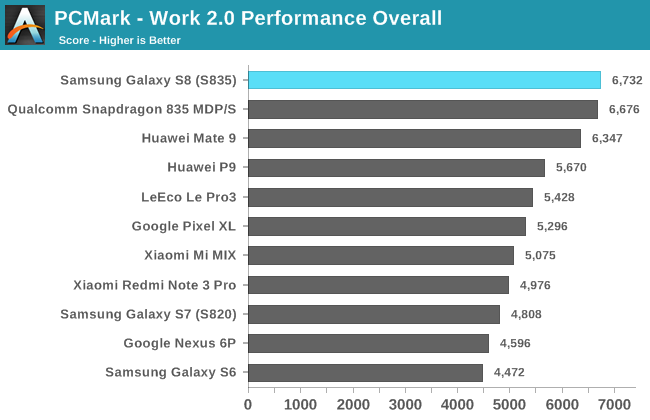
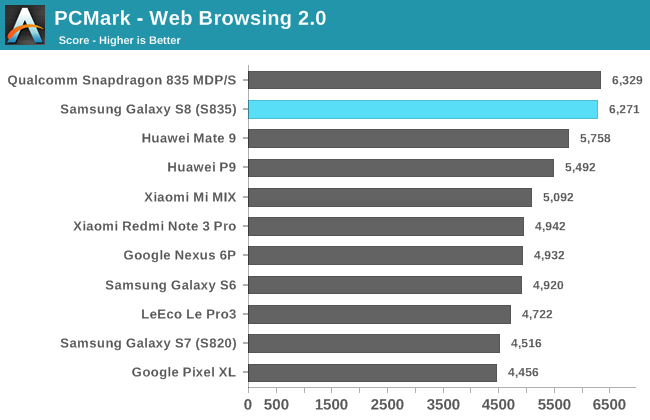
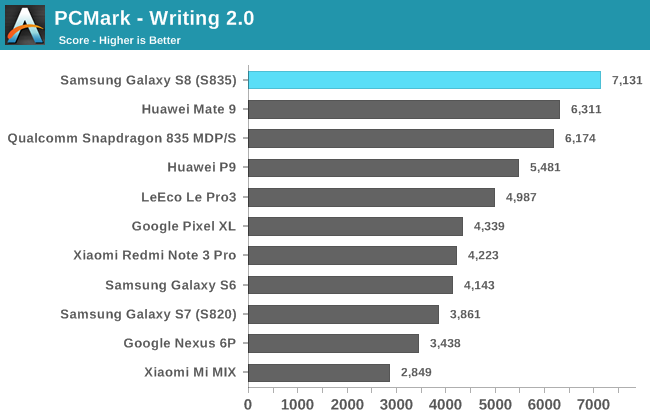
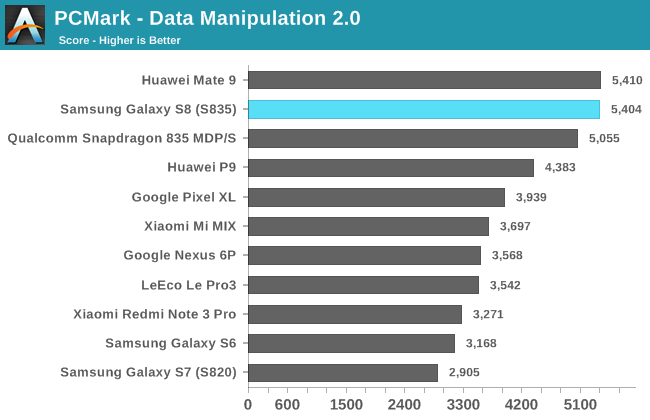
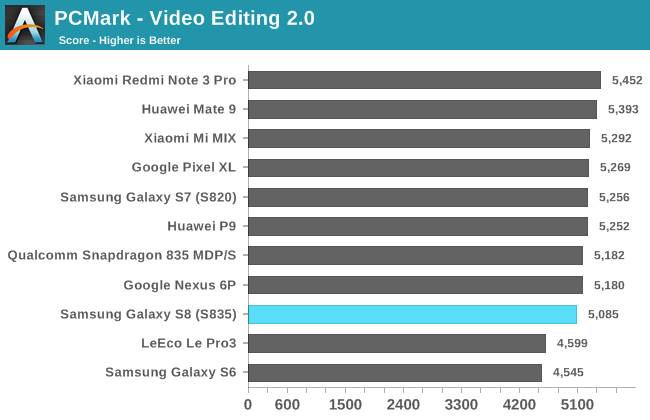
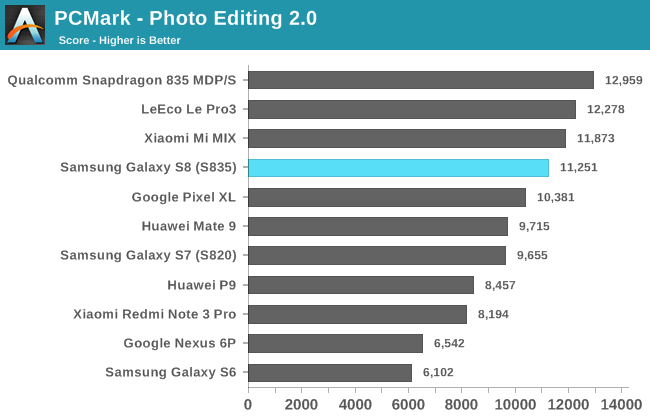
In PCMark, which is our best indicator of general system performance, the Galaxy S8 with Snapdragon 835 performs quite well, besting even the Mate 9 overall. Because this is the first S835 retail device we’ve tested, I’ve also included Qualcomm’s Snapdragon 835 MDP/S, which the company uses internally for hardware testing and software development, as a reference point. In most of these tests, the Galaxy S8 performs about the same as the Snapdragon 835 MDP/S, which is certainly a good sign.
The Galaxy S8 does particularly well in the Writing test, outscoring the Mate 9 by 13% and the Galaxy S7 (Snapdragon 820) by 85%. The Writing test, which previous Galaxy phones struggle with, uses a fairly bursty workload, frequently migrating threads between the little and big cores. Perhaps this is an indication that Samsung is utilizing the big cores more aggressively than in the past. The Galaxy S8 is also 9% faster than the Mate 9 in the Web Browsing test and 37% faster than the S7 (S820).

The Galaxy S8 achieves over 8 hours of screen-on-time while continuously crunching through the PCMark workloads, 46% longer than the Galaxy S7 that has the same 3000mAh battery, which suggests some nice efficiency gains from the new SoC, display, or other components. While the Galaxy S7 can struggle to last a full day on a single charge depending on how it’s used, these initial results suggest the Galaxy S8 will encounter fewer scenarios where it will need to use its fast charging or wireless charging abilities to stretch battery life till the end of the day.
While we’ve only had the Galaxy S8 for a couple of days, our first impression is generally positive. It’s packed with features, TouchWiz is more refined, and it performed well in our first performance and battery life tests. A few issues are already apparent, however. Your face probably will not be smiling if you try to rely on it to unlock the phone, and the fingerprint sensor is located in just about the worst possible place. Samsung’s Bixby assistant also is not yet fully functional; fortunately, you can still use Google Assistant while you’re waiting for Bixby to mature.










129 Comments
View All Comments
SilthDraeth - Friday, April 21, 2017 - link
So face unlock can't recognize your face, yet can unlock via a picture of your face?Agent Smith - Saturday, April 22, 2017 - link
Why no Apple iPhone comparisons, is this a joke?vision33r - Sunday, April 23, 2017 - link
Because the SD835 still doesn't even beat the iPhone 6S in performance and just barely beats iPhone 6. That's how sad the state of the Android vs iPhone performance. But it doesn't matter unless you are into heavy gaming.Notmyusualid - Monday, April 24, 2017 - link
If the Cr@pple was 5x faster - I still wouldn't buy it.IUU - Saturday, April 22, 2017 - link
So, you read about all the nice specs, relatively powerful cpus and gpus(at least in the mobile space), sweet beautiful screens, at last decent amounts of storage and ram(for the price a flagship phone commands) and about to post a positive comment, when you see the last spec....and you can't help bitching, even if you don't like it!
3000 mah battery , why? All the gains in efficiency practically nullified. A bigger screen and a smaller battery ??? Those making "mobile" devices need to understand , that phones are now computers with a newly established "need" to be used as such. So, using the "phone" as described, will barely get you through the day(don't talk to me about fast charging, when you run out of battery there is usually no socket around to charge). If it was a "budget" phone, this would be a sacrifice you would be willing to make to get the functionality , while being a bit socket anxious, and restrained in your daily use.
But this is a flagship phone, that will cost about as a lower range ,midrange pc. If the newer model does not make substantial gains towards lasting more, it is a lost game. I belong to a group of consumers who are value aware regarding computing devices. Meaning , I subconsciously and automatically measure their performance and classify them as more capable , less capable and in this way , if they deserve the price they ask. In smartphones, part of their value is to have your computing with you always no matter if you are tied to a chair and a socket or not. There's no way I would spend this kind of money , to get this kind of battery life, especially if they seem to wish to make a fool out of me by providing the same battery with a larger screen. I will look for another phone, with better battery specs.
Being miserly in RAM, and storage was always ticking me off in the past. Not that I am completely satisfied now. But seeing this lame behavior still in 2017 , directed towards battery is annoying as hell. If it is about the edge that restricts the engineers, then I say to them I would gladly buy a phone with edges if it was making improvements in battery. So, you will say, are you blind , haven't you seen the gains in efficiency bla bla bla? What are they for if you increase screen size, and what you would get if you put a battery with increased capacity to match screen size increase?
lilmoe - Saturday, April 22, 2017 - link
I believe if you're being "value aware", you shouldn't be thinking about the latest flagship at this point in a mature smartphone market. There are lots of devices that offer MUCH better value. If you want to stick with a Galaxy, and you're not living in the US, I'd strongly recommend considering the Exynos GS7e. It's a much better value than premium mid-range devices like the OnePlus 3T, especially after the latest update. Battery life is stellar.IUU - Sunday, April 23, 2017 - link
In fact I examine all my options. And of course l will go to another solution, given the circumstances. Plus, the better performance will almost never be seen , as you will almost always be relying on good old cortex a53 to keep your battery. Plus, the faster cores are not so fast, nor can you use this phone in productivity environments easily (not any other phone for that matter), because of lack of universal connectivity with common peripherals. Thus, the better performance is mostly a moot point.This, added to the fact of subpar battery makes me so vocal.At least, they are not Apple where you beg to have storage versatility and you are always at a loss regarding the General organisation and structure of your files.negusp - Sunday, April 23, 2017 - link
Better price for value than the OP3T? Are you crazy?The OP3T costs around $200 less than an unlocked Exynos GS7e. Not to mention better dev support, warranty that covers unlocked bl's/root, and a fairly easily replaceable battery.
Chidoro - Sunday, April 23, 2017 - link
Get a Motorola Z play and be done with it. If you are the odd one in a million that can not get a day of use out of that phone, slap a battery mod on the back.The SD625 is no slouch either.
zodiacfml - Saturday, April 22, 2017 - link
Wow, amazing battery life result which haven't found elsewhere. The difference might have been bigger if there's less screen on during the test